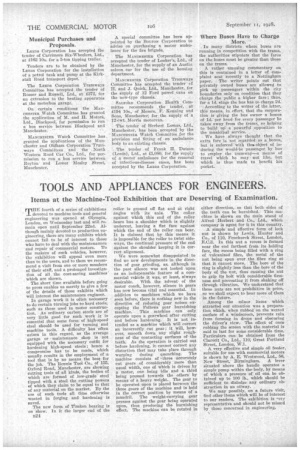TOOLS AND APPLIANCES FOR ENGINEERS.
Page 8

If you've noticed an error in this article please click here to report it so we can fix it.
Items at the Machine-Tool Exhibition that are Deserving of Examination.
THE fourth of a series of exhibitions
• 1 devoted to machine tools and general engineering was opened at Olympia, London, on Wednesday last and will remain open until September 22nd. Although mainly devoted to production engineering, there are many exhibits which cannot fail to be of interest to those who have to deal with the maintenannce • and repair of commercial motors. To the makers of such vehicles, however, the exhibition will appeal even more than to the users, and to them we recommend a visit from one or more members of their staff, and a prolonged investigation of all the cost-saving machines' which are shown.
The short time available before going to press enables us merely to give a few of the details of those exhibits which will interest the maintenance engineer.
In garage work it is often necessary to do certain turning jobs to. bard steels, such as those used in motor construction. As ordinary carbon steels are of very little good for such Work it is essential that some form of high-speed steel should be used for turning and machine tools. A difficulty has often arisen in this regard, as the average garage or maintenance shop is not equipped with the necessary outfit for hardening high-speed steels ; hence a compromise has to be made, which usually results in the employment of a tool that is by no means the best for the job. The Rennie Tool Co., of 155, Oxford Road, Manchester, are showing cutting tools of all kinds, the bodies of which are formed of low-grade steel tipped with a steel the cutting powers of which they claim to be equal to that of any material on the market. By the use of such tools all time otherwise wasted in forging and hardening is saved.
The new form of Timken bearing is on show. In it the larger end of the n24 roller is ground off flat and at right angles with its axis. The collar against which this end of the roller bears has a shoulder which is slightly undercut, leaving a flat face against which the end of the roller can bear. It is claimed that by this means it is impossible for the roller to twist sideways, the continual pressure of the end against the shoulder keeping it in correct alignment.
We were somewhat disappointed to find no new developments in the direction of gear grinding, as, although in the past silence was not looked upon as an indispensable feature of a commercial vehicle it was, at least, always desirable. With the advent of the motor coach, however, silence in gears has now become 'vital and essential. In addition to machines which we have seen before, there is nothing new in the direction of reducing gear noises excepting the Fellows gear burnishing machine. This machine can only operate upon a gearwheel after cutting and before hardening. It is not intended as a machine which will correct an incorrectly cut gear ; it will, however, smooth down any slight roughness of the contacting surfaces of the teeth. As the operation is catried out • before hardening, it cannot correct any distortion that may take place through warping during quenching. The machine consists of 'three accurately Cut gears of considerably more than usual width, one of which is driven by a motor, one being idle and a third being pressed towards the others by means of a heavy weight. The gear to be operated upon is placed between the three gears of the machine and is held in the correct position by means of a mandril. The weight-carrying gear presses against the gear being operated upon, thus producing the burnishing effect. The machine can be rotated in either direction, so that both sides of the teeth can be burnished. This machine is shown on the main stand of Alfred Herbert and Co., Ltd., which company is agent for it in this country.
A simple and effective form of lock nut is shown by Lewis, Hunter and Co., of 110, Fenc.hurch Street, London, E.C.3. In this nut a recess is formed near the end farthest from its holding face, the recess being filled with a ring of vulcanized fibre, the metal of the nut being spun over the fibre ring st, that, it cannot move. The bore of the
• ring is slightly less than the bore of the body of the nut, thus causing the nut to grip its bolt with considerable firmness and preventing it from shaking off through vibration. We understand that these nuts are not prohibitive in price, so we shall expect to hear more of them in the future.
• Among the minor items which attracted our attention was a preparation which, when rubbed on the wetted • surface of a windscreen, prevents rain from forming in drops and obscuring the driver's view. The effect of once rubbing the screen with the material is said to last for some considerable time. Particulars can be obtained from the Clarocit Co., Ltd., 110, Great Portland Street, London, W.1.
A very effective and simple oil feeder, suitable for use with commercial motors is shown by A. E. Westwood, Ltd., 56, New Street, Birmingham. A lever situated above the handle operates a simple pump within the body, by means of which a pressure of oil can be obtained up to 100 lb., which should he sufficient to dislodge any ordinary obstruction in an oilway.
We may possibly, on a future visit, find other items which will be of interest to our readers. The exhibition is -cry representative and should not be missed by those concerned in engineering.






























